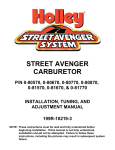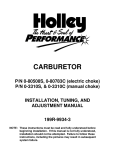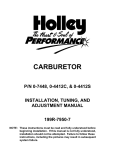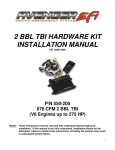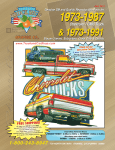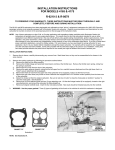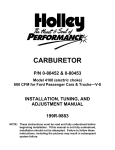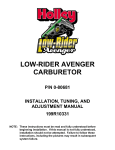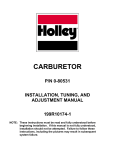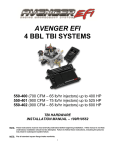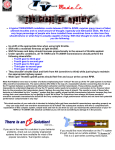Download Holley 950-19S Fuel Injection Kit Installation Instructions
Transcript
2 BBL TBI HARDWARE KIT INSTALLATION MANUAL P/N 950-19S & 950-20S NOTE: These instructions must be read and fully understood before beginning installation. If this manual is not fully understood, installation should not be attempted. Failure to follow these instructions, including the pictures may result in subsequent system failure. TABLE OF CONTENTS: 1.0 INTRODUCTION ..................................................................................................................................................................... 3 2.0 CHOOSING THE RIGHT SYSTEM ......................................................................................................................................... 3 3.0 WARNINGS, NOTES, AND NOTICES .................................................................................................................................... 4 4.0 PARTS IDENTIFICATION ....................................................................................................................................................... 5 5.0 ADDITIONAL ITEMS REQUIRED FOR INSTALLATION ........................................................................................................ 9 6.0 TOOLS REQUIRED FOR INSTALLATION.............................................................................................................................. 9 7.0 REMOVAL OF EXISTING FUEL SYSTEM.............................................................................................................................. 9 8.0 COMMANDER 950 SYSTEM INSTALLATION...................................................................................................................... 10 8.1 Throttle Body Installation.................................................................................................................................................... 10 8.1.1 Installing Throttle Body on Square Flange Manifolds (see Fig. 1A) .............................................................................. 10 8.1.2 Installing Throttle Body on Universal & Spread Bore Manifolds (see Fig. 1B & 1C) ..................................................... 10 8.1.3 Installing Throttle Body on Other Manifolds .................................................................................................................. 11 8.1.4 Vacuum Line Connection to the Throttle Body.............................................................................................................. 11 8.1.5 Throttle Lever Extension Bracket.................................................................................................................................. 12 8.1.6 Throttle Cable and Kickdown Brackets ......................................................................................................................... 12 8.1.7 Throttle Cable and Transmission Connectors............................................................................................................... 13 8.1.8 Air Temperature Sensor Installation ............................................................................................................................. 13 8.2 Map Sensor Installation...................................................................................................................................................... 13 8.3 Fuel Pump Installation........................................................................................................................................................ 14 8.4 Dual Tank Installation......................................................................................................................................................... 15 8.5 Fuel Pump Filter................................................................................................................................................................. 16 8.6 Throttle Body Fuel Filter ..................................................................................................................................................... 16 8.7 Return Line Installation....................................................................................................................................................... 17 8.8 Return to fuel tank system.................................................................................................................................................. 17 8.9 Fuel Line Connections to the Throttle Body ....................................................................................................................... 18 8.10 Oxygen Sensor Installation .............................................................................................................................................. 18 8.10.1 Oxygen Sensor Function, Theory, and Use ............................................................................................................... 18 8.10.2 Oxygen Sensor Mounting Procedure ......................................................................................................................... 19 9.0 THROTTLE BODY INJECTION SPECIFIC TUNING ............................................................................................................ 19 1.0 INTRODUCTION Holley Performance Products has written this manual for the installation of the COMMANDER 950 TBI fuel injection system. This manual contains the information necessary for the hardware installation. Please read all the WARNINGS, NOTES and TIPS, as they contain valuable information that can save you time and money. It is our intent to provide the best possible products for our customer; products that perform properly and satisfy your expectations. Should you need information or parts assistance, please contact our technical service department at 1-270-781-9741, Monday through Friday, 7 a.m. to 5 p.m. Central Time. By using this number, you may obtain any information and/or parts assistance that you may require. Please have the part number of the product you purchased when you call. The 950-19S and 950-20S kits are universal kits. Adapters are included for most square and spread bore manifolds. Engines that don’t use square bore or spread bore intakes will likely need an adapter fabricated. Many times the adapters included can be modified for other applications. The customer is responsible for this and any throttle and transmission linkage modifications necessary. NOTE: This manual is for the hardware installation of a Holley Throttle Body Fuel Injection System and instructions specific to it. Instructions on wiring harness installation, software operation, sensor operation, and tuning is contained in the supplied additional manual 199R-10149-5. NOTE: A laptop computer with a serial communications port is required for the installation and tuning of this system. WARNING! The COMMANDER 950 system consists of a number of sophisticated components. Failure of any one component does not constitute, nor does it justify, warranty of the complete system. Individual service items are available for replacement of components. If assistance is required or if you need further warranty clarification, you can call Holley Technical Service at the number shown above. WARNING! To preserve warranty, these instructions must be read and followed thoroughly and completely before and during installation. It is important that you become familiar with the parts and the installation of the COMMANDER 950 system before you begin. Failure to read and understand these instructions could result in damage to COMMANDER 950 components that are not covered by the warranty and could result in serious personal injury and property damage. WARNING! For closed loop systems using an oxygen sensor, use only unleaded fuels with this product. Use of leaded fuels will destroy the oxygen sensor and will result in incorrect exhaust gas oxygen readings and improper fuel delivery. Failure to follow these directions does not constitute the right to a warranty claim. WARNING! Failure to follow all of the above will result in an improper installation, which may lead to personal injury, including death, and/or property damage. Improper installation and/or use of this or any Holley product will void all warranties. WARNING! Use of some RTV silicone sealers will destroy the oxygen sensor used with this product. Ensure the RTV silicone sealant you use is compatible with oxygen sensor vehicles. This information should be found on the oxygen sensor package. 2.0 CHOOSING THE RIGHT SYSTEM To ensure that you have purchased the correct COMMANDER 950 kit for your application, check to be sure that the kit you purchased is listed beside your engine’s horsepower. For best results in the event of an application overlap, the correct kit choice is the one that the engine horsepower is more centered in the application. For example, if your engine is rated at 210 hp, look at the chart below, you will notice that there are 2 kits that could fit your application. 210 hp is near the upper limit of Kit # 950-19S. 210 hp is more centered in the horsepower range of Kit # 950-20S. The correct choice would be one of the kits listed in the 125 to 275 horsepower range. HORSEPOWER KIT PART NUMBER 100 - 225 hp ........................................................... 950-19S COMMANDER 950 TBI, 400 CFM 125 - 275 hp ........................................................... 950-20S COMMANDER 950 TBI, 670 CFM 3.0 WARNINGS, NOTES, AND NOTICES WARNING! For the safety and protection of you and others, only a trained mechanic having adequate fuel system experience must perform the installation, adjustment, and repair. It is particularly important to remember one of the very basic principles of safety: fuel vapors are heavier than air and tend to collect in low places where an explosive fuel/air mixture may be ignited by any spark or flame resulting in property damage, personal injury, and/or death. Extreme caution must be exercised to prevent spillage and thus eliminate the formation of such fuel vapors. WARNING! This type of work MUST be performed in a well-ventilated area. Do not smoke or have an open flame present near gasoline vapors or a explosion may result. 4.0 PARTS IDENTIFICATION ITEM 1 2 3 4 5 6 7 8 9 10 11 12 13 14 15 16 17 18 19 20 21 22 23 24 25 26 27 28 29 30 31 32 33 34 35 36 37 38 39 40 41 42 43 44 45 46 47 48 49 50 51 52 53 54 DESCRIPTION Commander 950 ECU Commander 950 Software Commander 950 Harness Commander 950 Communications Cable Fuel Pump Fuel Pump Clamp Metal Fuel Filter Oxygen Sensor Fuel Filter Clamp Fuel Pump Block-Off Plate & Gasket Plastic Fuel Filter MAP Sensor Coolant Temperature Sensor Air Cleaner Gasket TBI Stud Oxygen Sensor Weld Ring 40 AMP Relay Throttle Bracket Throttle and Cruise Control Stud Throttle Lever Ball Throttle Lever Bracket Throttle Lever Shipping Spring Throttle Lever Stud Transmission Kickdown Stud Hose Clamp Grommet Assorted Parts & Terminals Cable Ties Tube Cap Lockwasher 1/4-28 Nut 5/16-24 Nut 5/16" Vacuum Line Fuel Pump wiring Harness Throttle Bracket Throttle Bracket Air Cleaner Spacer Adapter Adapter Gasket Distribution Ring Gasket Air Temperature Sensor Gasket Air Cleaner Stud Throttle Stud Bolt Socket Screw Socket Screw Socket Screw Bolt Throttle Body Plug Locking Nut TBI Service Parts: Air Temperature Sensor Fuel Pressure Regulator Diaphragm Optional Parts: GM Distributor Wiring Adapter Ford Distributor Wiring Adapter QTY 1 1 1 1 1 1 1 1 1 1 1 1 1 1 1 1 2 1 1 1 1 1 1 1 8 1 1 12 1 2 2 4 1 1 1 1 1 1 1 1 1 1 1 1 1 1 3 4 4 4 3 1 3 4 SERVICE PART 534-120 534-144 534-158 534-140 512-105 N/A 562-1 43-106 108-10 12-813 562-3 538-24 534-2 108-4 N/A 534-49 534-26 N/A N/A N/A N/A N/A N/A N/A N/A N/A 534-42 N/A N/A N/A N/A N/A N/A N/A N/A N/A N/A N/A N/A N/A N/A N/A 534-46 N/A N/A N/A N/A N/A N/A N/A N/A N/A N/A N/A 1 1 534-46 512-1 1 1 534-138 534-139 Item 1 Item 4 Item 7 Item 10 Item 13 Item 16 Item 2 Item 5 Item 3 Item 6 Item 8 Item 11 Item 9 Item 12 Item 14 Item 15 Item 17 Item 18 Item 19 Item 22 Item 25 Item 20 Item 21 Item 23 Item 24 Item 26 Item 28 Item 31 Item 34 Item 27 Item 29 Item 32 Item 35 Item 30 Item 33 Item 36 Item 37 Item 38 Item 40 Item 41 Item 43 Item 46 Item 49 Item 52 Item 44 Item 47 Item 50 Item 39 Item 42 Item 45 Item 48 Item 51 Item 53 Item 54 5.0 ADDITIONAL ITEMS REQUIRED FOR INSTALLATION • 3/8" fuel hose (must meet SAE J30) • 5/16" steel fuel line (must meet SAE J526) • Tee fitting for fuel gauge • 5/16" fuel hose (must meet SAE J30) • 0-30 psi fuel gauge (if fuel pres. needs to be changed from 21 PSI) If an intake adapter other than the included square bore and spread bore adapters are needed, one must be fabricated by the customer. It is possible a new throttle and transmission cable bracket may be necessary. 6.0 TOOLS REQUIRED FOR INSTALLATION • • • • • Standard wrench set • Small blade screwdriver • 5/32” Allen wrench • #2 Phillips screwdriver • Digital Volt-Ohm meter Medium blade screwdriver • Terminal crimping tool Drill and assorted bit sizes • Hole saw (2”) • Utility knife Engine tachometer • 10” adjustable wrench • Windows compatible laptop PC Factory Service Manual for your vehicle • An assistant is necessary for some installation and adjustment procedures and should be present for safety reasons. 7.0 REMOVAL OF EXISTING FUEL SYSTEM 1. Disconnect the battery and remove the air cleaner. 2. Before disconnecting any vacuum hoses, it is a good idea to sketch out the vacuum hose routing. Using masking tape and a permanent marker, mark all the vacuum hoses, vacuum sources, and ports before removing the old fuel delivery system. 3. Remove and discard the fuel line that connects the fuel delivery system from the fuel pump. This will not be needed in the installation. 4. Disconnect and plug the inlet fuel line that runs from the gas tank to the fuel pump. This will prevent fuel spillage and foreign matter or dirt from entering the fuel line. DANGER! BEFORE DISCONNECTING OR REMOVING FUEL LINES, ENSURE THE ENGINE IS COLD. DO NOT SMOKE. EXTINGUISH ALL OPEN FLAMES. AN OPEN FLAME, SPARK, OR EXTREME HEAT NEAR GASOLINE CAN RESULT IN A FIRE OR EXPLOSION CAUSING PROPERTY DAMAGE, SERIOUS INJURY, AND/OR DEATH. 5. The fuel delivery system can now be removed. Holley recommends removing the mechanical fuel pump, if so equipped, and blocking-off the fuel pump mount using the provided fuel pump block off plate. The COMMANDER 950 system kit includes a block-off plate that will fit small and big block Chevrolet and Chrysler engines. If the block-off plate does not fit your engine, a block-off plate may have to be purchased from a local performance parts supplier. 6. If required, replace the intake manifold at this time. Proceed to step seven if this is not required. TO USE THE INCLUDED INTAKE ADAPTERS, A 4-BARREL STOCK OR AFTERMARKET INTAKE MANIFOLD IS REQUIRED. 7. Place clean shop towels or rags into the manifold opening to prevent dirt or debris from entering the engine. Keep exposed ends of the vacuum and fuel lines free from dirt. WARNING! Failure to cover the intake opening with a clean towel could result in dirt or debris entering the engine. Dirt or debris in the induction system can cause engine damage, which may necessitate in a complete engine overhaul. 8. Remove all traces of the old gasket material from the TBI mounting flange. DO NOT gouge the intake manifold sealing surface during removal of old gasket material. Failure to remove all traces of the old gasket material will result in vacuum leaks that will be difficult to detect later. Sealing flanges must be clean and dry before installation. 9. Remove the shop towels from the intake and vacuum out the intake channel to ensure no dirt or debris is left in the intake system. Place a shop towel over the entire intake opening until you are ready to install the new COMMANDER 950 TBI. 8.0 COMMANDER 950 SYSTEM INSTALLATION 8.1 Throttle Body Installation 8.1.1 Installing Throttle Body on Square Flange Manifolds (see Fig. 1A) 1. Clean the manifold flange and remove any residual gasket or sealing material. Make sure you do not drop any parts or debris in the engine. This may result in damage to the engine. 2. Place the Universal Manifold Adapter gasket (item 42) on top of the manifold flange and position it so that the gasket covers all of the sealing surfaces. 3. Place the square flange adapter plate (item 39) on top of the flange gasket so that the holes in the adapter plate are located towards the front of the vehicle. 4. Secure the adapter plate with the four socket head screws (item 49) and torque the screws to 5 to 7 ft./lbs. in a criss-cross pattern. 5. Insert the coarse threaded end of the three 5/16” studs (item 15) into the adapter place and secure the studs to the adapter plate by screwing them into the adapter plate. 6. Place the TBI flange gasket (item 44) over the three 5/16” studs. 7. Place the throttle body on top of the TBI flange gasket by placing the throttle body over the 5/16” studs. 8. Secure the throttle body in place with the three nylon locking nuts (item 54) and torque each of the nuts to 5 to 7 ft./lbs. Figure 1A—Square Bore Figure 1B—SB Chevrolet Figure 1C—All Other Spread Bore 8.1.2 Installing Throttle Body on Universal & Spread Bore Manifolds (see Fig. 1B & 1C) NOTE: The Universal Manifold Adapter Plate (item 38) has six threaded throttle body mounting holes. Only three of these will be used to mount the throttle body. The remaining three holes must be plugged by inserting a plug (item 53) into each hole. Apply a small amount of Loctite® to each plug and secure them with a 5/32” hex wrench. 1. Clean the manifold flange and remove any residual gasket or sealing material. Make sure you do not drop any parts or debris in the engine. This may result in damage to the engine. 2. Place the Universal Manifold Adapter Gasket (item 42) on top of manifold flange and position it so that the gasket covers all of the sealing surfaces. 3. Place the adapter plate (item 38) on top of the flange gasket, placing the holes in the adapter plate towards the front of the vehicle. NOTE: On Small Block Chevrolet applications with stock intake manifolds, the adapter plate should be installed so that the adapter plate’s bores are located over the large secondary bores on the manifold. If you experience problems with the fit of the universal adapter plate, Holley recommends the installation of part #17-6, Spread Bore Adapter, underneath the Universal adapter plate. NOTE: If you are using an aftermarket manifold with a Small Block Chevrolet application, position the adapter plate bores so that they are located towards the front of the intake manifold. On all other applications, except for those described, position the adapter plate bores so that they are located towards the front of the intake manifold. NOTE: On stock Big Block Chevrolet applications, the throttle body must be mounted towards the front of the manifold, even though the bore holes will not line up correctly. This is necessary to prevent the front cylinders from running too lean. If you experience problems with the fit of the universal adapter plate, Holley recommends the installation of part #17-6, Spread Bore Adapter, underneath the Universal Adapter Plate. 4. Secure the adapter plate to the manifold with the four socket-head screws (item 49) and torque them 5 to 7 ft./lbs. (60-84 in./lbs.) in a criss-cross pattern. 5. Insert the coarse threaded end of the three 5/16” studs (item 15) into the adapter plate and secure the studs to the adapter plate by screwing the studs into the adapter plate. 6. Place the TBI flange gasket (item 44) over the three 5/16” studs. 7. Place the throttle body on top of the TBI flange gasket by placing the throttle body over the 5/16” studs. 8. Secure the throttle body in place with the three locking nuts (item 54) and torque each to 5-7 ft./lbs. 8.1.3 Installing Throttle Body on Other Manifolds This system can be installed on any 4, 6, or 8 cylinder even fire engine. If an adapter plate is not available for the application, an existing spacer will have to be modified or a new on made. In many cases one of the existing adapter plates can be modified to fit other engines. If this does not work, a custom adapter will have to be machined. 8.1.4 Vacuum Line Connection to the Throttle Body 1. Inspect all of the vacuum lines that were disconnected during removal of the stock fuel system for any signs of wear or damage and replace those that are in need of repair. 2. Connect all of the vacuum lines that were labeled during the disassembly of the stock fuel system to the throttle body. Figure 2 shows which ports are for manifold and ported vacuum and also PCV. The single fitting on the back of the throttle body is for manifold vacuum. 3. Plug all of the vacuum ports on the throttle body that are not used with vacuum plugs. Failure to plug off unused vacuum ports will cause vacuum leaks, resulting in very poor performance. 4. Using the supplied vacuum line, connect the MAP sensor to a manifold vacuum source on the throttle body. Figure 2 8.1.5 Throttle Lever Extension Bracket NOTE: The installation of the throttle lever extension bracket onto the throttle body is OPTIONAL. This bracket is used to provide a more gentle rate at which the throttle opens and to reduce the force required to depress the accelerator pedal. Ensure that there is sufficient clearance between the bracket and the air cleaner assembly to prevent any binding. 1. Locate that throttle lever extension bracket (item 21), two hex head bolts (item 26), three lockwashers (item 18), three hex nuts (item 32), and the transmission kick-down stud (item 24). 2. Secure the bottom hole of the bracket to the bottom hole of the throttle lever on the throttle body with one of the hex head bolts and secure it to the throttle lever with a hex nut and lockwasher. If you are installing a transmission kick-down cable or lever, secure the throttle lever extension bracket throttle lever with the transmission kick-down stud instead of a hex bolt. 3. Secure the center hole on the bracket to the top hole of the throttle lever on the throttle body with one of the hex head bolts, hex nuts, and lockwashers. 4. Install the throttle arm stud (item 19) or ball stud (item 20) in the top hole of the throttle lever extension bracket and secure the stud with one of the hex and lockwashers. Figure 3 8.1.6 Throttle Cable and Kickdown Brackets NOTE: General Motors automatic overdrive transmissions require the use of a special bracket and/or hardware to ensure proper operation. 1. For vehicles equipped with the OE 4-barrel spread bore manifold and a GM TH700R4 transmission, use Holley PN 20-96 2. For vehicles equipped with an aftermarket 4 barrel intake manifold and a GM TH700R4 transmission, use Holley PN 20-97. NOTE: For Ford automatic overdrive transmissions, a linkage kit is available from Total Performance in Mt. Clemens, MI; (313) 468-3673. NOTE: For Chrysler applications, the use of a kick-down linkage kit is required to actuate the Chrysler transmission linkage, Holley PN 20-7. Chrysler van applications may require the use of a throttle lever extension, Holley PN 20-14. NOTE: Some General Motors vehicles require the installation of a stud (item 46) in the drivers side rear corner of the adapter plate for use when mounting the appropriate throttle bracket. 1. Select the appropriate throttle bracket for you application (if available). The longer of the two brackets is usually used on stock manifold applications, while the shorter bracket is usually used with aftermarket manifolds. 2. Install the bracket over the stud installed in the rear driver’s side corner of the adapter plate and secure the bracket with a 5/16”-24 hex nut. NOTE: For General Motors spread bore applications, also install the transmission bracket (item 46). This bracket will move the cable to compensate for the throttle body being mounted over the secondary bores. 8.1.7 Throttle Cable and Transmission Connectors NOTE: On some Ford applications, it may be necessary to lengthen the automatic transmission kick-down rod for proper transmission operation. A kit used to lengthen this rod is available from Holley, PN 20-41. DANGER! PROPERLY ADJUST BOTH THE THROTTLE CABLE AND TRANSMISSION LEVER/CABLE. FAILURE TO DO SO MAY RESULT IN UNCONTROLLED ENGINE AND VEHICLE SPEED, RESULTING IN PROPERTY DAMAGE, PERSONAL INJURY, AND/OR DEATH. 1. Attach the throttle cable to the stud installed on the throttle linkage on the throttle body. 2. While another person fully depresses the accelerator pedal, adjust the throttle cable to ensure that the travel of the accelerator pedal allows for both wide open throttle and idle. 3. Once the throttle cable has been adjusted, operate the linkage several times back and forth to ensure that it operates smoothly, with no binding or sticking. 4. Attach the transmission kick-down lever, or overdrive cable, to the appropriate bracket, and adjust either the lever or the cable to ensure that the transmission operates properly. WARNING! Over tightening the TBI manifold flange hold-down-nuts may result in a warped or cracked throttle body. The TBI hold down nuts should be tightened down progressively in a criss-cross pattern to 5-7 ft lbs., to prevent leaks and avoid causing damage to the throttle body. A TBI that has been damaged due to negligence of the owner will void the warranty. 8.1.8 Air Temperature Sensor Installation The air temperature sensor should be installed somewhere in the inlet tract. The air temp sensor has a two-pin Packard connector with blue and black wires. The 199R-10149-5 instruction manual includes the wiring harness installation. 8.2 Map Sensor Installation The MAP sensor will have to be mounted to the engine or the firewall. The MAP sensor should be mounted so that the vacuum port is facing completely down or at an angle. (See Figure 4). If it is not, fuel or condensation can enter the sensor and damage it. Make sure a vacuum line is connected from the MAP sensor to a manifold vacuum source on the throttle body. Figure 4—Proper Map Sensor Mounting Orientation 8.3 Fuel Pump Installation 1. Do not mount the fuel pump higher than the lowest point of the fuel tank. 2. Mount the fuel pump as close as possible to the fuel tank. 3. Make sure fuel tank is properly vented. DANGER! NEVER GET UNDER A VEHICLE SUPPORTED ONLY BY A JACK. SERIOUS INJURY OR DEATH CAN RESULT FROM VEHICLES FALLING OFF OF JACKS. BEFORE WORKING UNDERNEATH A VEHICLE, SUPPORT IT SOLIDLY WITH JACK STANDS. 4. Mount the electric fuel pump as close to the fuel tank outlet as possible with the bracket provided. Mounting the fuel pump in this manner will insure that the pump will prime easily and purge fuel vapors in the TBI quickly to ensure faster starts. DANGER! TAKE PRECAUTIONS TO ENSURE THAT ALL FUEL LINE ROUTINGS ARE AWAY FROM HEAT SOURCES, SUCH AS THE ENGINE OR EXHAUST PIPES. A FIRE OR EXPLOSION HAZARD COULD CAUSE SERIOUS INJURY OR DEATH. DANGER! ENSURE THAT THE FUEL PUMP MOUNTING LOCATION WILL NOT INTERFERE WITH ANY UNDER THE VEHICLE COMPONENTS, ESPECIALLY AT THE EXTREME LIMITS OF THE SUSPENSION TRAVEL. A FIRE OR EXPLOSION HAZARD COULD CAUSE SERIOUS INJURY OR DEATH. Figure 5 5. Connect the pump to the tank using 3/8” I.D. fuel hose. Connect the outlet of the pump to the steel line, which runs to the front of the vehicle with 3/8” I.D. fuel hose, depending on the diameter of the steel fuel line. All fuel hoses used must meet SAE J30 performance standards. DANGER! FAILURE TO USE A FUEL HOSE THAT MEETS SAE J30 STANDARDS COULD RESULT IN FUEL LEAKS. A FUEL LEAK MAY RESULT IN A FIRE OR EXPLOSION HAZARD, WHICH COULD CAUSE SERIOUS INJURY OR DEATH. 6. If using existing fuel lines, inspect and replace any hose, clamps, or fuel line showing ANY sign of aging. If you are not using existing fuel lines, you will need a fuel line routed to the engine compartment and COMMANDER 950 throttle body. Use a 3/8” steel fuel line available at any auto parts store. All steel fuel line must meet SAE J526 standards. DANGER! FAILURE TO USE STEEL A FUEL LINE THAT MEETS SAE J526 STANDARDS COULD RESULT IN FUEL LEAKS. A FUEL LEAK MAY RESULT IN A FIRE OR EXPLOSION HAZARD, WHICH COULD CAUSE SERIOUS INJURY OR DEATH. DANGER! TAKE PRECAUTIONS TO ENSURE THAT ALL FUEL LINE ROUTINGS ARE AWAY FROM HEAT SOURCES, SUCH AS THE ENGINE OR EXHAUST PIPES. A FIRE OR EXPLOSION HAZARD COULD CAUSE SERIOUS INJURY OR DEATH. DANGER! RIGID FUEL LINE TUBING SHOULD BE USED FOR UNDER VEHICLE RUNS, SUCH AS ALONG VEHICLE FRAME RAILS OR UNDER FLOOR PANS. FAILURE TO DO SO IS A POTENTIAL FIRE OR EXPLOSION HAZARD, WHICH COULD CAUSE SERIOUS INJURY OR DEATH. 7. Anchor all fuel lines securely to solid chassis members at 1 ½ foot intervals using rubber coated steel clamps. Use of only approved steel fuel line tubing will afford maximum fuel line protection against road hazards and premature wearing due to flexing, temperature extremes, road salt, weather, etc. NOTE: Inlet fuel pressure should be preset to 21 PSI from the factory. 8.4 Dual Tank Installation The following are special instructions for vehicles equipped with dual fuel tanks. Holley COMMANDER 950 fuel injection systems require a fuel return line and in dual tank applications, the fuel must be returned to the tank from which it was drawn. The items listed below are recommended to properly install your COMMANDER 950 TBI system on a dual tank vehicle. A separate fuel pump and filter for each tank will be necessary. Holley offers these items in a kit, part number 534-37. Item Selection valve Valve Connector Toggle switch Relay Fuel pump 10 amp in line fuse Fuel filter Part Number 42-149 42-203 34-576 534-26 512-103 562-3 This is a recommended list and except for the fuel pump, equivalent parts may be substituted. In addition, fuel hose, clamps, 18 gauge wire, and assorted terminals will be needed. The selection valve recommended switches tanks by reversing the polarity of the “D” and “E” terminals. Many trucks equipped with dual tanks already have this type of selection valve along with the associated hardware. 1. Mount the selection valve in a protected location close to the existing fuel lines and near the fuel tanks. Position the valve so the side with the four hose nipples points toward the fuel tanks. Mount the fuel pumps along the fuel supply lines and next to each fuel tank. Fuel filters (Holley Part Number 562-3) MUST be located between each tank and pump. Make sure pump inlets point toward the tanks. (See Figure 6). WARNING! The supply and return hoses from the same tank must be connected next to each other on the selection valve. 2. All hoses should be secured with worm gear type clamps. Avoid sharp bends in the fuel lines. 3. Mount the double-position, double-throw toggle switch, along with the relay under the dash if the vehicle is not already equipped with this type switch. Connect the electrical wiring, as shown in Figure 7 on the next page. NOTE: Mount the double position, double throw toggle switch along with the relay under the dash if the vehicle is not already equipped with this type switch. Connect the electrical wiring, as shown in Figure 7 on the next page. Figure 6 The terminals on the plug-in connector are labeled A - F and should be wired to the following items: A B C D E F 4. Fuel sending unit, tank #1 Fuel gauge at dash Fuel sending unit, tank #2 Fuel pump #2 (+12v) and switch Fuel pump #1 (+12v) and switch Not used Plug the connector into the selection valve. Double check all fuel and electrical connections to be sure they are installed properly. Electrical connections should be insulated and sealed to prevent arcing and corrosion. Check the operation of the selection valve when the COMMANDER 950 TBI system installation is complete. Figure 7 8.5 Fuel Pump Filter A filter MUST be installed between the fuel tank and the fuel pump inlet. The purpose of this filter is to protect the fuel pump from particles of dirt or other foreign material. The plastic filter should be installed with the arrow on the filter pointing in the direction of the fuel flow. Secure the ends of the fuel lines with hose clamps. If a metal filter is desired, use a generic 5/16” or 3/8” carburetor filter available at any auto parts store. 8.6 Throttle Body Fuel Filter The 10 micron metal fuel filter that is included with the COMMANDER 950 TBI system should be installed between the electric pump outlet and the inlet fitting of the TBI. Position the filter, so the fuel hoses can be routed without kinks or sharp bends. The filter should be installed with the arrow on the filter pointing in the direction of the fuel flow. Secure the ends of the fuel lines with hose clamps. Conveniently mount the fuel filter and clamp assembly using the hole provided in the clamp. WARNING! Ensure both filters are installed in the proper direction. A flow direction arrow is stamped on the side of the filter to indicate the direction of fuel flow. Failure to do so will result in a system malfunction. DANGER! TAKE PRECAUTIONS TO ENSURE ALL FUEL LINE ROUTINGS ARE AWAY FROM HEAT SOURCES, SUCH AS THE ENGINE OR EXHAUST SYSTEM. A FIRE OR EXPLOSION HAZARD COULD CAUSE PROPERTY DAMAGE, SERIOUS INJURY, AND/OR DEATH. 8.7 Return Line Installation The Holley COMMANDER 950 TBI system requires a return fuel line to the fuel tank. Some late model vehicles that were originally equipped with a throttle body injection system may already have a return line to the fuel tank that can be utilized. If a return fuel line must be installed, a minimum size of 5/16” I.D. is recommended. DANGER! DO NOT USE THE VAPOR CANISTER LINES AS A FUEL RETURN LINE. POSSIBLE FUEL LEAKS MAY CREATE A FIRE OR EXPLOSION HAZARD, CAUSING SERIOUS INJURY OR DEATH. WARNING! Use only approved steel fuel line. The return fuel line should enter the fuel tank at the “fuel level sending unit flange” or at the “filler neck”. The filler neck or sending unit must be removed from the tank to perform this operation. DANGER! PROPER INSTALLATION OF THE FUEL RETURN LINE MAY NECESSITATE COMPLETE REMOVAL OF THE FUEL TANK. THIS WORK SHOULD BE DONE BY A FUEL TANK SPECIALIST, WHO REGULARLY DOES THIS WORK AND IS FAMILIAR WITH SAFETY REGULATIONS AND PRECAUTIONS NECESSARY TO DO THIS WORK. IF A PERSON ATTEMPTS THIS WORK, WHO IS NOT FAMILIAR WITH THE SAFETY REGULATIONS AND PRECAUTIONS, AN EXPLOSION HAZARD MAY RESULT CAUSING SERIOUS INJURY OR DEATH. Figure 8 8.8 Return to fuel tank system 1. Install a 5/16” return line hose from the 5/16” return fitting in the throttle body to a fitting in the fuel tank. Use the supplied hose clamps to ensure that the fuel line fittings are tight at both ends of the hose. Figure 9 The system tuning and checkout process advises that a fuel pressure gauge be installed in the return line system. This is a good time to consider how this pressure gauge can be installed. Attach a section of 5/16” hose to the outlet of the throttle body and secure with a hose clamp. Run the other end to either the fuel tank or the inlet of the pump at the tee fitting as previously discussed in earlier text. Secure with a hose clamp. NOTE: The return line pressure should be as close to “0” zero as possible. The fuel pressure should be no higher than 3 psi. 8.9 Fuel Line Connections to the Throttle Body WARNING! The fuel pressure in the fuel return line MUST be less than 3 PSI for the system to operate properly. Fuel return line pressure of 3 PSI or more will result from the return line being too small, a restriction in the line, or too many bends. Return fuel pressure in excess of 3 PSI may result in an excessive fuel condition (flooding) which may cause stalling or hard starting. 1. Locate the fuel inlet fitting on the throttle body. It is located on the driver’s side of the vehicle with the fuel fittings facing the rear of the vehicle. 2. Attach the fuel supply line to the fuel inlet fitting on the throttle body with 3/8” ID J30 fuel hose and secure the fuel supply line to the fitting with a hose clamp. 3. Locate the fuel outlet fitting on the throttle body. It is located on the passenger side of the vehicle with the fuel fitting facing the rear of the vehicle. 4. Attach the fuel return line to the fuel return outlet fitting on the throttle body with 5/16” ID J30 fuel hose and secure the fuel return line to the fitting with a hose clamp. 8.10 Oxygen Sensor Installation 8.10.1 Oxygen Sensor Function, Theory, and Use The COMMANDER 950 allows the user to operate their engine in a closed loop fuel management mode using the oxygen sensor. The oxygen sensor monitors the exhaust gases and outputs a voltage that corresponds to the fuel/air mixture. The range of voltage output from the oxygen sensor is 0.0 to 1.0 volts. A lean air/fuel mixture gives a lower oxygen sensor output voltage, while a rich air/fuel mixture gives a higher oxygen sensor output voltage. The stoichiometric or chemically perfect air/fuel mixture gives an oxygen sensor output of approximately 0.5 volts. The engine ECU reads this output from the oxygen sensor and adjusts the fuel delivery to maintain a stoichiometric fuel/air mixture. Most automobiles, both currently and for the past 20 years, are using oxygen sensors to monitor the engine fuel/air mixture. This is done primarily to improve engine emissions. It also gives the advantage of maintaining a stoichiometric fuel/air mixture under varied operating conditions giving generally better engine performance and fuel economy. Holley includes oxygen sensor feedback capability with the COMMANDER 950 system and recommends the user to use the oxygen sensor. For most user applications, better performance and fuel economy will be obtained by using the oxygen sensor. In addition, the oxygen sensor can make the tuning process much easier, since the user can monitor the ECU functions as it adjusts the fuel to meet a stoichiometric fuel/air mixture. The mounting location of the oxygen sensor is extremely important for the proper operation of the engine. The exhaust gas temperature (EGT) in the exhaust, where the sensor is mounted, is very important for proper closed loop operation. If the EGT is too low, two undesirable conditions can result. First, the ECU may sense that the O2 sensor is not up to proper temperature and will not activate closed loop operation. Second, the sensor could emit a false low voltage, even if the air/fuel ratio is rich. The ECU will see this as a lean condition and add fuel to compensate in closed loop mode. This makes the rich condition even worse, which will lower the EGT and complicate the problem. The lower the EGT the sensor sees, the slower the sensor will react, reducing the benefits of closed loop operation. The minimum recommended temperature for reasonable closed loop operation is 800°F (Fahrenheit) at the sensor. Maximum continuous temperature at the sensor is 1500°F. Most engines idle with an EGT of 800-1100°F near the cylinder head exhaust port. If the sensor is mounted far away, such as in the collector of long tube headers, the temperature may drop to as low as 300°F at idle. If the oxygen sensor attempts to control the air/fuel ratio when the EGT it sees is between 300 and 600°F, the problems mentioned above can occur. It is recommended to mount the oxygen sensor as close as possible, where one bank of cylinders merge together. If an OEM mounting location is available, use it. With stock cast iron manifolds, the sensor can be mounted in the exhaust pipe, right after the cast iron manifold in the exhaust pipe or possibly in the end of the manifold itself. If the vehicle has “shorty” headers, the sensor can be mounted in the collector of the headers. If the vehicle has long tube headers, the sensor can be mounted in the collector, but the temperature will likely be too low at idle for proper operation. A fix for this, if proper closed loop operation does not occur, is to run open loop at lower engine speeds, until enough heat is available for proper operation. This is programmable in the ECU. Other factors, such as camshaft specifications, will effect how well closed loop operation occurs at low engine speeds and loads. 8.10.2 Oxygen Sensor Mounting Procedure NOTE: Someone with experience in welding exhaust systems should install the oxygen sensor boss. Any competent exhaust shop is able to perform this task at a minimum cost. WARNING! Use only unleaded fuel when operating an oxygen sensor. Use of leaded fuels will destroy the oxygen sensor and will result in incorrect exhaust gas oxygen-content readings. WARNING! Use of some RTV silicone sealers will destroy the oxygen sensor used with this product. Ensure the RTV silicone sealant you use is compatible with oxygen sensor vehicles. This information should be found on the oxygen sensor package. 1. Locate a position for the oxygen sensor as close to the engine as possible. If your vehicle has catalytic converters, the oxygen sensor MUST be located between the engine and the catalytic converters. NOTE: The oxygen sensor should be mounted in such a way that the condensation in the exhaust tubing will not enter the sensor. Mount the O2 sensor in the upper half of the exhaust tubing, with the angle “x”, shown above, being greater than 10°. The picture above indicates that the sensor can be mounted on either side of the exhaust tubing. 2. Drill a 7/8” hole in the location picked for the sensor. Weld the threaded boss into the 7/8” hole. Weld all the way around the boss to insure a leak proof connection. Install the oxygen sensor into the threaded boss and tighten securely. It is a good idea to add anti-seize to the threads to aid in removal. 3. On vehicles equipped with an AIR pump, the oxygen sensor must be mounted before the AIR injection into the exhaust, or the AIR pump must be disconnected. Holley recommends that if the AIR is injected into both exhaust manifolds, mount the oxygen sensor into the pipe immediately after the exhaust manifold. Disconnect the AIR pump tube from the exhaust manifold and plug both ends. Check with local ordinances for the legality of this procedure in your area. WARNING! Failure to disconnect the AIR pump or locating the oxygen sensor downstream from AIR injection will result in an extremely rich mixture, which could cause driveability problems and severe engine damage. WARNING! It is important that the distribution ring is properly installed and fastened to the throttle body. Failure to do so will cause an inadequate seal between the throttle body and air cleaner and may be a fire hazard in the event of a backfire. Fire hazard can result in property damage, serious injury, and/or death. 9.0 THROTTLE BODY INJECTION SPECIFIC TUNING The throttle body injection (TBI) systems have several items to note. The factory should have preset the fuel pressure at 21 psi. This should be checked, if possible, before the tuning is performed. The injectors can operate down to 10 psi. The pressure can safely be raised above 21 psi. Idle Fuel Pulse Width Ideally the injector pulse width at idle should not be below 1.7 milliseconds (ms). This value is seen on the data monitor. If the value is less than this, the fuel pressure can be lowered. This allows for the pulse width to be increased to a value above 1.7 ms. NOTE: For wiring harness installation and tuning information, please see the supplied additional manual. Holley Technical Support P.O. Box 10360 Bowling Green, KY 42102-7360 Phone: 1-270-781-9741 Fax: 1-270-781-9772 For online help, please refer to the Tech Service section of our website: www.holley.com Copyright © 2002 Printed in U.S.A. 199R-10262 Date: 2-21-02 Holley Performance Products




















